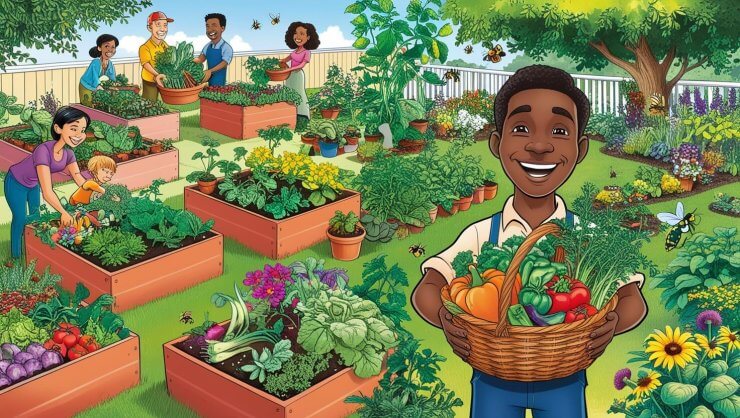Read by Michael Flamel

In neighborhoods across the United States, a gardening movement that took root during the pandemic is blossoming into a full-scale green revolution. What began as a lockdown pastime has grown into a national passion for homegrown produce. According to the National Gardening Association, nearly 35 percent of U.S. households—over 45 million homes—are growing at least some of their own food. That’s enough kale to fill Yankee Stadium (repeatedly) or a tomato trail long enough to wrap around the earth!
How America’s Gardens Grew
The pandemic may have driven people to their yards, but the lasting appeal of food gardening lies in its many rewards—stress relief, healthier eating, cost savings, and a sense of connection to nature. Post-pandemic, food gardeners have dug in deeper, exploring new ways to cultivate crops at home.
- Raised Beds: More than 50 percent of food gardeners now use raised beds, ideal for compact spaces and soil control. They’re particularly popular in suburban backyards.
- Container Gardening: The fastest-growing trend, especially among renters and city dwellers. From five-gallon buckets to designer planters, containers are sprouting everything from lettuce to Meyer lemon trees.
- In-Ground Gardening: This classic method remains a favorite for families with large yards, where sprawling plots can accommodate corn, pumpkins, and more.
America’s Favorite Crops
Food gardens today are as diverse as the people growing them. While tomatoes reign supreme, many other crops are climbing the charts. According to surveys by the Garden Research Foundation:
- Tomatoes: Grown by 90 percent of food gardeners, they are the undeniable stars of the garden.
- Herbs: Basil, cilantro, and rosemary lead the herbaceous charge, adding fresh flair to meals.
- Peppers: Sweet or spicy, over 75 percent of gardeners plant them to add crunch and heat.
- Squash and Zucchini: Easy to grow and wildly productive, these are Summer staples.
- Carrots and Radishes: Perfect for beginner gardeners and kids eager to “harvest treasure.”
Digging Into the Data
The numbers tell a fascinating story about how and why Americans are embracing food gardening:
- Financial Impact: The average gardener grows enough to save $600 annually on groceries.
- Demographics: Millennials are leading the gardening boom, with over 50 percent starting during the pandemic. Gen Z is catching on fast, making gardening a multi-generational movement.
- Pollinator Power: Nearly 30 percent of food gardeners also cultivate pollinator-friendly plants, supporting vital species like bees and butterflies.
- Small Spaces, Big Yields: Container gardening has seen a 30 percent increase, proving you don’t need a backyard to grow food.
Why We Keep Growing
Whether it’s the thrill of harvesting a sun-ripened tomato or the satisfaction of turning a handful of seeds into a vibrant vegetable patch, food gardening offers unmatched rewards. As one gardener in Atlanta shared: “I started during the pandemic because I had time on my hands. Now, it’s part of who I am—it’s therapy, food, and fun all rolled into one.”
The benefits extend beyond the backyard. Community gardens are thriving, seed swaps are buzzing, and social media groups are connecting green thumbs across the country. The pandemic may have planted the seeds, but this gardening renaissance is rooted in a deeper appreciation for fresh, sustainable food and the joy of nurturing life.
This article was prepared by Don Nicholas, your intrepid gardening reporter and home food gardening enthusiast. If you’ve ever considered helping others dig into food gardening, now is the perfect time to get your friends and neighbors to join the movement that’s growing a brighter future for America, one tomato at a time! ❖


 Previous
Previous


